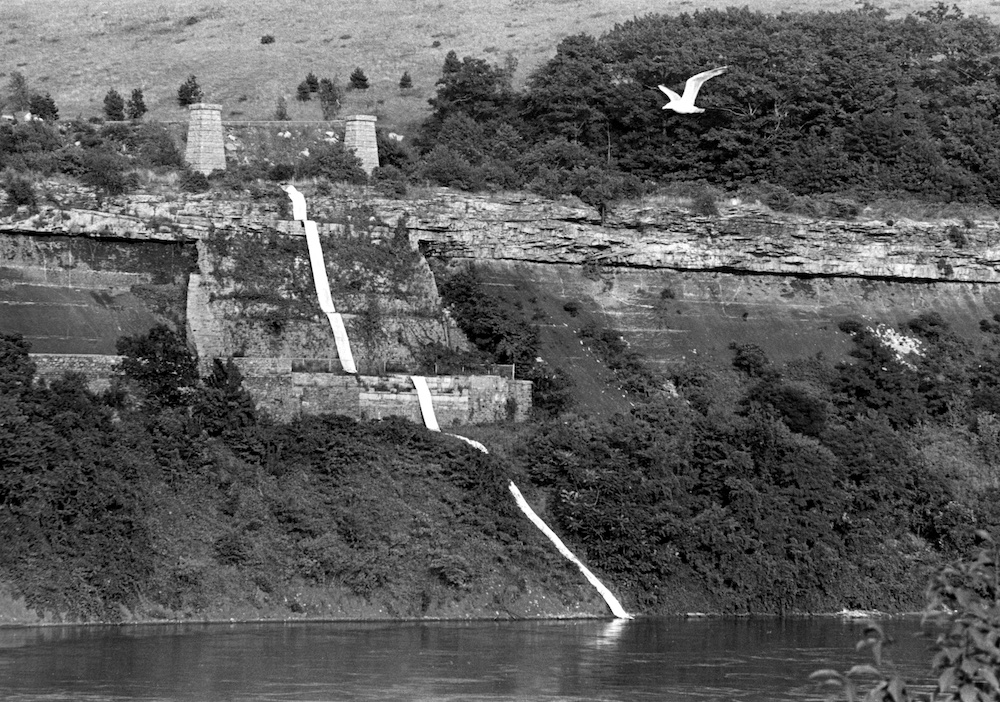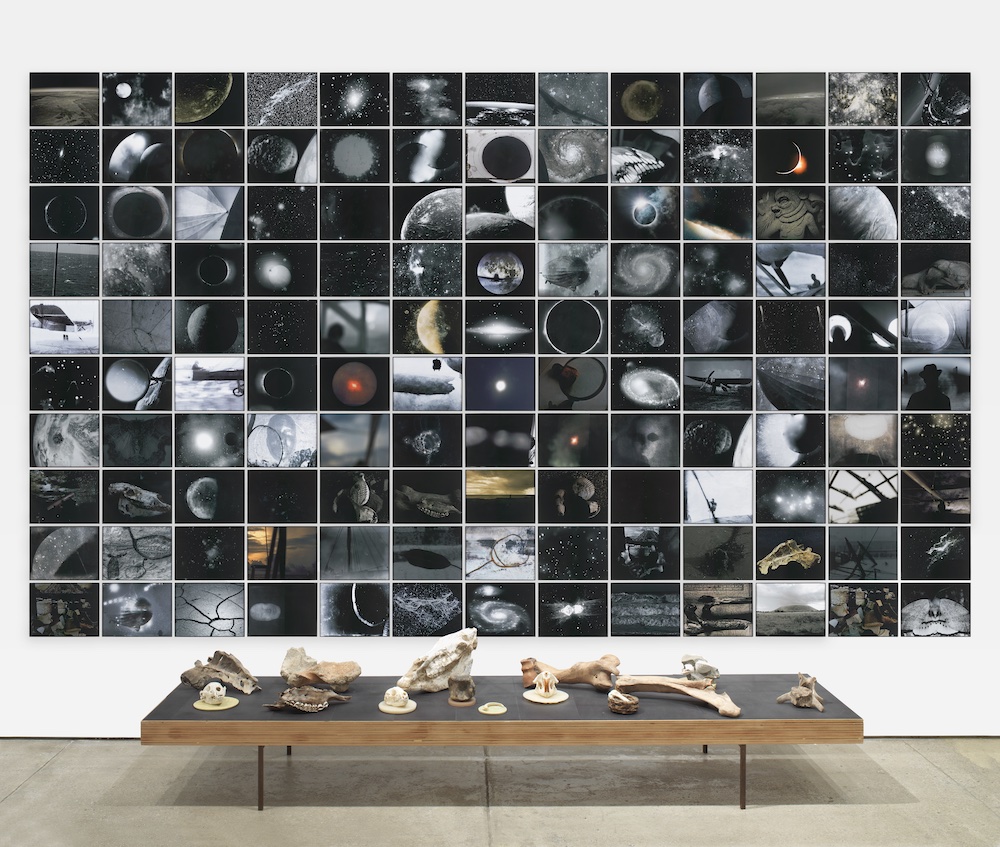Monumentality is not the point of Michelle Stuart’s work. “Connection” doesn’t exactly sum it up either, although it’s always there. Transit or transition would be closer to it—although it would have to be understood within a post-Einsteinian view of the universe and its moving and multi-dimensional aspects.
I wanted to trace those connections and transitions in Stuart’s work to that connective sense she forged early on, growing up in Los Angeles and Southern California before explosive urban development transformed the landscape into what we know today.
At one point, I asked her about grid formats she’s applied frequently in her works over the years, and her response underscores what distinguishes her art from the monumentally scaled work of some of her peers.
ARTILLERY: Was that about time or mapping or both?
MICHELLE STUART: Absolutely both. As far as I’m concerned, they go hand in hand. We’ve made time calendrical. The time element is maybe the most important—time elements were really the seeds of my development.
These are excerpts from two conversations I had with Stuart—first remotely from LA and later at her New York studio—lightly edited for clarity.
MICHELLE STUART: None of the works that I did out in the land were meant to be permanent pieces. They weren’t meant as monuments. I thought of them as experiments in a way. They were things I’d thought of and wanted to do, or commissions I was given and decided to re-do into something I actually wanted to do.
You started very early playing with ideas about the moon and the moon’s connection with the earth and its oceans.
I started doing drawings of the moon in the late 1960s. I grew up in California. Anybody who grows up in California must feel that. I went to the ocean all the time, and you’re almost always involved with the tides, the moon.
It’s very much on a similar wavelength with writers like Rachel Carson, making that connection between the moon, the oceans, and the rest of our planet as a living, breathing biomass—that emerging sense of both topography and cosmology.
You always felt it at the beach. You felt the pull of the tides. Even if you look at the stones that you find on the beach …
The very early Americans—especially the Mayans—were very much on that wave. We now know [from archaeological evidence] that a lot of the hieroglyphs we have from the Maya are about cosmology and the moon, pairing different things they encountered as part of their being.
Your works frequently take the form of mappings, also classification and calendaring—the gridding of time. Where do you think that approach towards the actual tracing of time began in your work?
I think I started working with the grid in the 1960s—I did moon drawings with grids, too.
When I started doing seed drawings in Oregon—they started out as calendrical drawings …That piece in Oregon—Stone Alignments/Solstice Cairns—that was a calendrical piece the connection with the land; and the movement in time.
“That piece,” as she puts it, is nothing less than one of the most important (and given its setting alone, one of the most beautiful) earthworks produced in the wave of Land Art or Earthworks between the late 1960s and 1970s, pioneered by (among many others) Robert Smithson, James Turrell, Alan Sonfist, curator Willoughby Sharp and the gallerist, Virginia Dwan. From rocks piled into cairns set into axial points of a somewhat hexagonal ring (approximately 100 feet in diameter) of stones pulled from the Hood River (by Stuart and an assistant—and some distance from this glacier-chiseled gorge of the Columbia River), Stuart marked the point of sunrise and sunset at the summer solstice. Stuart’s journal notes documenting the piece, which reference poetry, are themselves nothing less than poetry.
Although the relative lack of preservation of this work seems (to me) nothing less than scandalous, the work itself, among several others I mentioned to Stuart, acknowledged this possibility.

Michelle Stuart, Niagara Gorge Path Relocated, 1975. Rocks, earth with strains of red iron oxide, on muslin-backed paper paper (site: Artpark, Lewiston, NY). 460′ x 5’2″ Photo Credit: George MacDonald © Michelle StuartCourtesy of Galerie Lelong & Co., New York
There’s this consciousness in your work that it will fade with time. And that seems to be part of it, part of what you’re talking about.
It’s interesting to bring up permanency because one piece I did in the mid-1980s for the Rose Museum (at Brandeis University, in Waltham, MA)—Ashes in Arcadia—I wish had been permanent because it was really a very early cry for what we’re doing to our world.
You were doing a lot of [earth-filled] boxes then. And books?
At that time I was doing paintings; and they were giving me a big painting show. And the curator said, “You know we have this room …” and I said, “I’ll take it.” I had this piece in my mind I wanted to do—and that was what I did.
It was a huge room with units on the wall I made from wax with garbage; and the entire floor was filled with ashes and books and pieces of twigs and branches and hidden lights behind the walls. You couldn’t really walk into it—you would just walk about five feet from the door into this room and there was the sound of a humpbacked whale. And you would be completely engaged in it.
The whale was indicative of what we were doing to our world—at first by killing them. And now we’re fucking up the ocean with plastic. It was almost unbelievable how moving it was. Now something like that I wish had been made into a permanent room in the museum. Well naturally it wasn’t. Yes—I was doing books, too.
In a lot of the earth drawings, whether they emerge as landscape or they’re gridded with this notional classification or time trace, there’s the sense of connection between earth and sky—and an ambiguity to it. When were you conscious of moving in that direction—towards these kinds of projects?
That’s hard to answer. Certainly with pieces like Niagara Gorge Path Relocated, I thought of the whole piece as water going up to the sky and coming down and hitting the earth and going into the river—that was in 1975. I wanted the viewer to be engaged physically with going into the piece—not just looking at it on the wall, but actually entering the space. And people sometimes would say, “it’s like coming to a cliff …”
We were talking about that sense of connecting to the sky, the atmosphere. What’s extraordinary [in Seeded Site (1969–70), Tate Modern] is this juxtaposition of the lunar landscape, which you’ve made longitudinal—with those inset seeds …
It was kind of the first seed piece in a way. I kept thinking at the time that how the moon relates to us—or how we relate to the moon. Certainly one of the ways was magnetic forces. It’s more than that of course. It’s the tides—the whole thing makes what grows grow.
And here [in Nazca Lines Star Chart and Southern Hemisphere Constellation Chart Correlation (1981)], you have this palpable sense of correspondences between the Earth and the stars.
I went there the same time as I went to the Galapagos—between 1981 and 1982. It’s in Peru—about 200 miles south of Lima. I drove down.
Stuart, 89, has long been fascinated with exchanges between cultures in various proximities with one another—both close and distant. Deep memory of distant sea voyage is all but imprinted into her DNA. In addition to Darwin, her childhood (and forever) heroes were Melville and Captain James Cook, whose explorations mapped virtually the entire Pacific “ring of fire.” But she is conscious of the extent that “ring” swept her up during her formative years in California.
As a child I was constantly going up the [Highway] 101 with my parents. There are some cliffs for you! That were falling down all the time. That’s like a perfect example of seeing time. Stratification. California is full of that.
Some of those early grid pieces, those frottages really had to do with earthquakes—the fault lines [Sequence Development: Fault Line is the title of a 1969 triptych, now at the Metropolitan Museum of Art]—so they, too, harkened back to my background in California, although I did them in New York.
Did you ever experience a California earthquake?
Who didn’t? I remember when I was a child, my father told me that not long after I was born, there had been a huge
earthquake and he rushed me to the door, to stand in the doorframe …there’s an earthquake a day in California.


